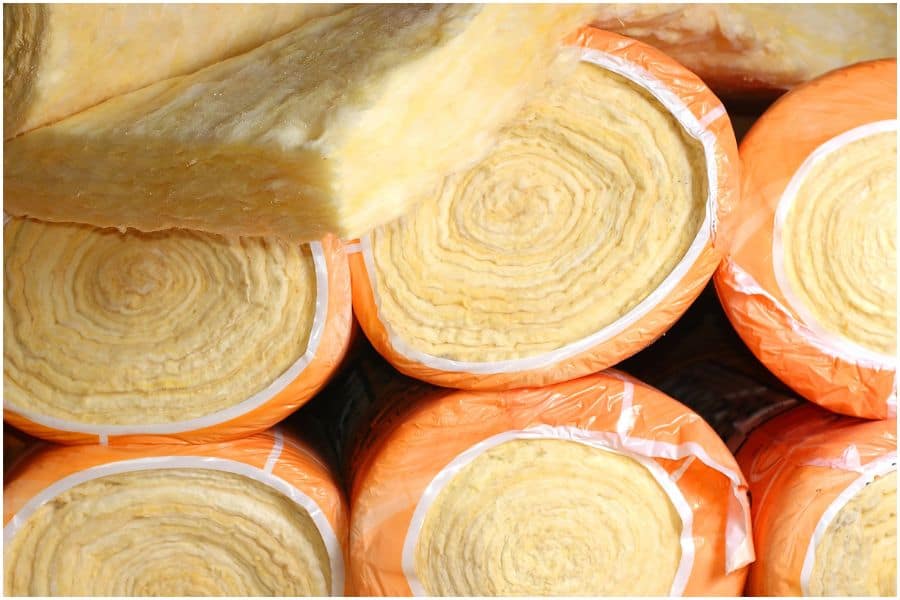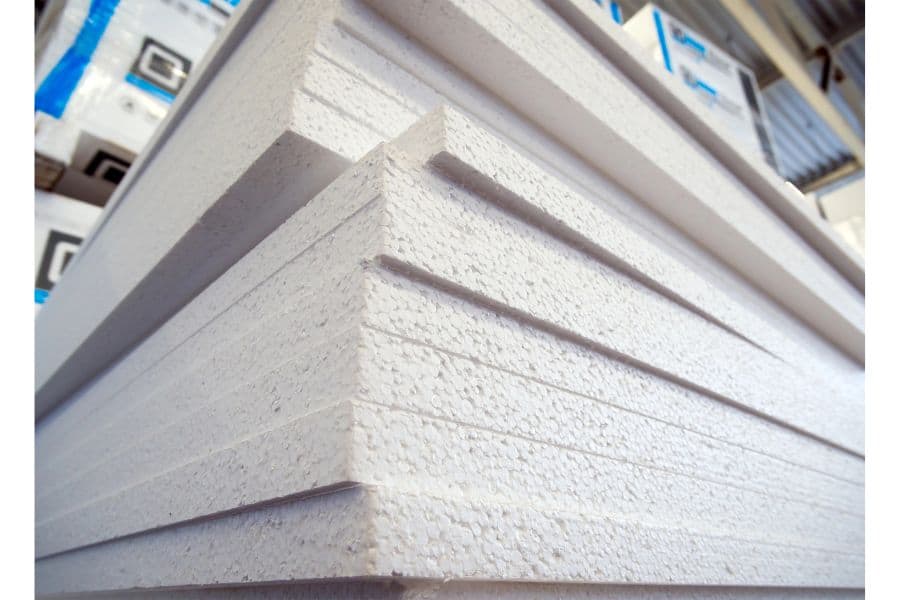Safest Non-Toxic Insulation (What To Use and Why)
Non-toxic insulation is one element in creating a safe haven from unnecessary toxins in your home. Many people don't know how much your health will benefit from choosing these types of non-toxic materials. If they do, they only think of the items you furnish your home with, not the materials you use for building it.

Insulation is one of the many elements that we have researched when reconstructing our house. This is currently in process for the third time, and it will be happening for a fourth time once we build our final home.
The first time we had to ponder a non-toxic insulation decision was when we redid our downstairs and added on living space. The second time is we renovated our kitchen and bathroom. The third time is when a tree fell through our house leaving our house unlivable and needing to be ripped down to the studs. This is the phase we are currently in as I write this post.
Our family's sensitivities to chemicals and high regard for using non toxic materials means we try and find the best non-toxic fit of building materials for our family. There are several safer options for insulation out there. They come in different forms but there is one particular that we have chosen to use and will use again.
what to look for when picking safe insulation
1. Insulation wITHOUT Volatile organic compounds
It is important to know if harmful chemicals will be off-gassing in your home posing health risks. Traditional insulation materials present problems to human health. Some of the elements that are found in these insulations are formaldehyde and asbestos.
Most insulations have been phased out and do not contain these in large amounts for purchase. However, older homes may still be insulated with them and caution needs to be taken when removing them. Additionally, formaldehyde can still be found quite often in insulation.
2. Insulation that Least Affects indoor air quality
Safe insulation still requires proper cautions to be put into practice when installing it. Fibers and particles can still be breathed into the respiratory tract during the installation process. Also, some forms of insulation require it to be handled by hand.
Therefore, following the best practices is encouraged. This site can help you with this.
3. Take into consideration The environmental impact
The environment needs to be considered as well when it comes to disposing of the insulation and materials used to make the insulation.
Some insulation is created with recycled materials while other insulation types is made with materials that require mining, sources that need to be extracted causing pollution, or the use of fossil fuels in some such as foam insulation.
Using insulation made from recycled matter is valued highly due to the use of less energy, and less erosion and pollution risks from mining or using less natural resources.
Although environmental concerns should be considered, it is also important to consider harmful chemicals that exist in the recycled materials. Finding a balance that works best for your health and sensitivities while considering environmental benefits is the best scenario.
Health Risks and concerns of using certain Insulations
Many insulations are now being offered that pose less health risks than in the past. However, there are definitely certain insulations out there that are created with materials that are more hazardous health-wise than others.
Even the "better choices" present possibilities for health concerns. Therefore, putting safety standards into place when putting insulation up is best.
Concerns include:
- Respiratory Issues
- Release of toxic chemicals from insulation that uses flame retardants
- Skin and eye irritations
- Off-gassing of harmful chemicals which can potentially cause disease and health issues
Types of insulation
1. Batts Insulation or Insulation Rolls

1. Cellulose Insulation

Cellulose insulation is made of recycled materials such as recycled newspapers, denim, or other non-synthetic fibers. Cellulose is often used as a blown-in insulation, however, it is available in batts form also. The downside is that it is usually more expensive than other batts-style insulations.
The controversy some may find with cellulose is the fact that although 70-85% of the cellulose is made from recycled material, the other percentage comes from the use of flame-retardants.
Flame-retardants generally want to be avoided. However, in this case, boric acid and ammonium sulfate are used. These components have been shown to cause respiratory problems when breathed in high-doses but not in low-doses.
Therefore, you will want to weigh the benefits and drawbacks in deciding if this natural material is safe enough for you. All insulations have their benefits and drawbacks. Cellulose may be a good choice for a natural insulation and creating the safest air quality environment for some.
Facts to consider about Cellulose insulation
- Boric acid and Borax are most often added to make cellulose flame retardant. This also makes the insulation more resistant to mold and rodents.
- Cellulose absorbs moisture and water. Although most cellulose contains boric acid meaning it resists mold, moisture and water absorption lays the groundwork for mold development. I am sure professionals have differing opinions about this, but I am reluctant to purchase cellulose because of this.
- It condenses over time making more air space and less insulated space.
3. Foam Boards

This type of insulation can make your house energy efficient. The foam boards can be used in all parts of the insulation process, and they insulate well. However, the use of these boards is not a non-toxic choice.
Foam boards consist of polystyrene, polyisocyanurate, and/ or polyurethane. Polystyrene is toxic and has been linked to health problems. Additionally, polyurethane consists of toxins that are off-gassed with the use of this type of insulation.
4. Blown-In Insulation

Blown-in insulation, also known as loose-fill, consists most often of cellulose, fiberglass, or mineral wool or rock wool. The insulation is blown in by a trained professional using a machine.
The small particles of one of the above materials are sprayed onto the wall or into the wall crevices. The amount of material used and the addition of other elements are dependent on the type of material blown in.
For instance, mineral wool may require an additional adhesive to get it to stick to the wall. Also, rock wool and mineral wool require less material used due to a heavier base than the use of cellulose.
Problems with blown-in insulation
- The traditional form of blown insulation uses fiberglass. This means small particles of glass can be breathed in causing respiratory harm.
- Chemicals are used to make cellulose insulation fire retardant. However, these chemicals are often boric acid or sodium borate. These chemicals are controversial concerning safety extent. However, many chemically sensitive people are fine using cellulose from my research.
- The small particles from loose-fill insulation are often airborne. This makes the indoor air quality contaminated.
- Vents may become blocked.
5. Concrete Forms

Concrete forms are highly energy efficient. Foam boards and rebar are the insulation materials that hold the casted concrete walls into place. The concrete becomes stable once dried, but the foam boards stay in place and are not removed. The process provides better insulation and strength.
6. Insulated forms Using wood or other natural fibers
Other forms consist of natural wood fibers to create and insulate walls. These fibers are a good non-toxic form that require less off-gasing due to the natural materials used.
The forms are created with a cement using wood fibers. They help regulate mold and mildew resistant and regulate humidity levels. These are a newer options for building and may be beneficial in a basement where moisture contol is needed.
best non-toxic insulation choices and brands
Rockwool Mineral Wool Batt Insulation
This type of insulation is a great non-toxic option. It has been our go-to for a couple of renovations now.
From experience, it is easy enough to install, and it does not bother our sensitivities. It comes in rolls and in different thicknesses.
The insulation also comes with sound-proofing choices which are nice to cut down on noise. We do not use the mineral insulation with flame retardants because they have too many dangerous chemicals that will offgas into the air.
Havelock Wool Batt insulation
Havelock wool insulation is a great choice as well. The insulation is made from wool sourced from New Zealand. The only other additive in the wool is boric acid.
Hempwool Batt Insulation
Another insulation product that is safe and can be considered is Hempwool. This product is mold resistant making it an option for the mold sensitive, and it is non-toxic.
Ecocell Cellulose Insulation
This can be a good choice for many people looking for an insulation created with cellulose. It does have several additives in the insulation, but it seems to be a safer option.
Ecocell insulation comes in batts so it does not require blowing in. I prefer batt insulation over blown-in insulation for the concerns listed above, therefore, this is the type of cellulose insulation I recommend.
Faswall Concrete Forms
The forms are blocks comprised of patented, organic materials. These forms are safe to use and have many positive benefits according to the company.
The benefits include sustainability, fire resistance, thermal efficiency, and are light in weight. These are a good choice for those building from scratch. These are an option we are considering in the building of our new non-toxic home.
This post gave you the reasons to use a non-toxic insulation when building or redoing your home and the best and safest non-toxic insulation choices available.
- https://www.paragon-protection.com/understanding-cellulose-insulation/
More Posts To Enjoy
Creating a safe space to cook, gather, and eat is important to setting a healthy and thriving environment. Do you want you family exposed to unnecessary toxins that could have been prevented? If the answer
Essential oils are an excellent way to optimize air quality. Why pollute the air more with toxins. Traditional sprays only mask odors with harmful chemicals or replace one impurity for another. Instead, use the best
Mold toxicity symptoms are life-changing and not in a good way. They can impact the health of you and your loved ones and create a wide-range of problems. Learning about the symptoms and best ways
This air purifying candle DIY actively fights mold and mildew lingering in the air leaving you with cleaner air for breathing. Using only a few simple ingredients, create a peace of mind knowing you are
Want to know how to Clean White Kitchen Cabinets naturally & most effectively? The answer is quite simple and the ingredients are safe and practical. White cabinets are beautiful as long as they are kept
Mold prevention is a MUST for keeping your living space safe. There are many factors that come in to play as to why mold will develop in a space. But if you are in need
- https://valleyinsulationllc.com/understand-four-types-of-blow-in-insulation/
- https://www.energy.gov/energysaver/types-insulation